Oxfordian (stage)
The Oxfordian is, in the ICS' geologic timescale, the earliest age of the Late Jurassic epoch, or the lowest stage of the Upper Jurassic series. It spans the time between 163.5 ± 4 Ma and 157.3 ± 4 Ma (million years ago). The Oxfordian is preceded by the Callovian and is followed by the Kimmeridgian.[1]
| Oxfordian | |
|---|---|
| 163.5 ± 1.0 – 157.3 ± 1.0 Ma | |
 Cyclically alternating limestone (light, more competent) and marl/clay layers of Oxfordian age at Péry-Reuchenette, near Tavannes, Jura Mountains, Switzerland. | |
| Chronology | |
Key events in the Jurassic -200 — – -195 — – -190 — – -185 — – -180 — – -175 — – -170 — – -165 — – -160 — – -155 — – -150 — – -145 — – how to approximate the timescale of key Jurassic events. Vertical axis: millions of years ago. | |
| Etymology | |
| Name formality | Formal |
| Usage Information | |
| Celestial body | Earth |
| Regional Usage | Global (ICS) |
| Time scale(s) used | ICS Time Scale |
| Definition | |
| Chronological unit | Age |
| Stratigraphic unit | Stage |
| Time span formality | Formal |
| Lower boundary definition | Not formally defined |
| Lower boundary definition candidates | Horizon of the Ammonite Cardioceras redcliffense. |
| Lower boundary GSSP candidate section(s) |
|
| Upper boundary definition | Not formally defined |
| Upper boundary definition candidates | FAD of the Ammonite Pictonia baylei |
| Upper boundary GSSP candidate section(s) | Flodigarry, Skye, Scotland, UK |
Stratigraphic definitions
The Oxfordian stage was called "Clunch Clay and Shale" by William Smith (1815–1816); in 1818 W. Buckland described them under the unwieldy title "Oxford, Forest or Fen Clay". The term Oxfordian was introduced by Alcide d'Orbigny in 1844. The name is derived from the English city of Oxford,[2] where the beds are well developed, but they crop out almost continuously from Dorset to the coast of Yorkshire, generally forming low, broad valleys. They are well exposed at Weymouth, Oxford, Bedford, Peterborough, and in the cliffs at Scarborough, Red Cliff and Gristhorpe Bay. Rocks of this age are found also in Uig and Skye.[3]
The base of the Oxfordian stage is defined as the point in the stratigraphic record where the ammonite species Brightia thuouxensis first appears. A global reference profile for the base (a GSSP) had in 2009 not yet been assigned. The top of the Oxfordian stage (the base of the Kimmeridgian) is at the first appearance of ammonite species Pictonia baylei.
In the Tethys domain, the Oxfordian contains six ammonite biozones:
- zone of Epipeltoceras bimammatum
- zone of Perishinctes bifurcatus
- zone of Gregoryceras transversarium
- zone of Perisphinctes plicatilis
- zone of Cardioceras cordatum
- zone of Quenstedtoceras mariae
Palaeontology
Amphibians
| Amphibians of the Oxfordian | ||||
|---|---|---|---|---|
| Taxa | Presence | Location | Description | Images |
| China | An extinct genus of small cryptobranchoid salamander. |  Chunerpeton | ||
| China; Mongolia; Russia | Gobiops desertus was a brachyopid temnospondyl. | |||
| China | Sinobrachyops placenticephalus was a brachyopid temnospondyl. | |||
†Choristodera
| Choristoderans of the Oxfordian | ||||
|---|---|---|---|---|
| Taxa | Presence | Location | Description | Images |
| China | A small choristoderan reptile, Coeruleodraco is significant as the most complete Jurassic choristodere taxon ever found worldwide. | |||
†Sauropods
| Sauropods of the Oxfordian | ||||
|---|---|---|---|---|
| Taxa | Presence | Location | Description | Images |
| Bathonian-Oxfordian | Originally thought to have lived form the Hauterivian to Barremian. | |||
†Ornithischians
| Ornithischians of the Oxfordian | ||||
|---|---|---|---|---|
| Taxa | Presence | Location | Description | Images |
| Oxfordian? Tithonian? | Chaoyang, Liaoning, China | A marginocephalian dinosaur from the Late Jurassic of China, belonged to the Ceratopsia, a group of primarily herbivorous dinosaurs with parrot-like beaks | 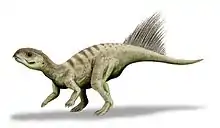 Chaoyangsaurus  Chialingosaurus  Chungkingosaurus  Dacentrurus  Tuojiangosaurus  Yinlong | |
| Upper Shaximiao Formation, Sichuan, China | A genus of stegosaur similar to Kentrosaurus | |||
| Upper Shaximiao Formation, Sichuan, China | One of the smallest of the stegosaurids at 3–4 metres (9.8–13.1 ft) long, Chungkingosaurus had at least five spikes on its thagomizer. It had a rather high and narrow skull and large, thick bony plates. | |||
| England, France, Spain, Portugal | A large stegosaurid | |||
| Dashanpu Formation, Sichuan, China | By extrapolation from the remains of possible species and other basal ornithopods, it was a herbivorous bipedal animal around 1.3 to 1.5 meters (4.3 to 4.9 ft) long. It would have been a strong runner | |||
| Junggar Basin, Xinjiang, China | A genus of stegosaurid | |||
| Upper Shaximiao Formation, Sichuan, China | The best understood of the Chinese stegosaurs. It was around 7.0 meters (23.0 feet) long and 2 meters (6.6 feet) high, with a postulated weight of around 4 metric tons (4.4 short tons). | |||
| Shishugou Formation, Xinjiang, China | A small, primarily bipedal herbivore, approximately 1.2 meters (3.9 feet) long, the oldest and most primitive ceratopsian known to science. | |||
†Plesiosaurians
| Plesiosaurians of the Oxfordian | ||||
|---|---|---|---|---|
| Taxa | Presence | Location | Description | Images |
| Jagua Formation, Cuba | A pliosaurid. It was thought be related to the similar but earlier Peloneustes, it might be a more derived pliosaurid related to its larger contemporary Pliosaurus. |  Gallardosaurus 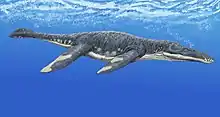 Liopleurodon  Megalneusaurus | ||
|
England and France | Liopleurodon is a genus of large pliosaurids. "Liopleurodon" grossouvrei, although synonymized with Pliosaurus andrewsi by most authors, may be a distinct genus in its own right given differences from P. andrewsi and Liopleurodon type species. | ||
| Sundance Formation, USA | A very large pliosaurid. It was an apex predator in its environment. | |||
| Sundance Formation, USA | A long necked medium-sized plesiosauroid of the family Cryptoclididae. | |||
| Bajocian-Tithonian | ||||
| Sundance Formation, USA | A long necked plesiosauroid. | |||
| Jagua Formation, Cuba | A long necked medium-sized plesiosauroid, once considered a species of the very closely related Cryptoclidus. | |||
†Thalattosuchians
| Thalattosuchians of the Oxfordian | ||||
|---|---|---|---|---|
| Taxa | Presence | Location | Description | Images |
| Oxfordian | France | A metriorhynchid nomen dubium, in the subfamily Geosaurinae. | ||
| Oxfordian to Valanginian | Cuba | A medium-sized metriorhynchid thalattosuchian in the tribe Rhacheosaurini. | ||
| Callovian to Oxfordian | France | A medium-sized metriorhynchid thalattosuchian in the subfamily Metriorhynchinae. | ||
Theropods
| †Non-coelurosaurian Theropods of the Oxfordian | ||||
|---|---|---|---|---|
| Taxa | Presence | Location | Description | Images |
| Bathonian- Oxfordian | Tiourarén Formation, Agadez Region, Niger | A large megalosaur. Originally thought to have lived from the Hauterivian to Barremian. |  Afrovenator | |
| Cañadón Asfalto Basin, Patagonia, Argentina | It was among the earliest large South American abelisaurs. With the discovery of Eoabelisaurus, the temporal range of the clade was extended for more than 40 million years into the Middle Jurassic. |  Eoabelisaurus | ||
| Oxford Clay, England | A 20-foot relative of Megalosaurus, lived 162-154 million years ago. | .jpg.webp) Eustreptospondylus | ||
| Shishugou Formation, Junggar Basin of Xinjiang, China | An elaphrosaurine ceratosaur from China measuring about 1.7 metres (5 ft 7 in) in length. |  Limusaurus | ||
| Oxford Clay, England | Metriacanthosaurus was a medium-sized theropod estimated at 1 tonne (1.1 short tons)weight and a length of 8 meters (26.2 feet). Most likely an allosauroid closely related to the contemporary Yangchuanosaurus. |  Metriacanthosaurus | ||
| Wucaiwan Member, Shishugou Formation, Xinjiang, China | Monolophosaurus was a basal medium-sized tetanuran theropod that grew to at least 5 meters (16 feet) long. It had an odd, unique crest on its head which ran most of the length of the skull. |  Monolophosaurus | ||
| Shishugou Formation, Junggar Basin of Xinjiang, China | A large metriacanthosaurid theropod. |  Sinraptor | ||
| Bathonian-Oxfordian | Tiourarén Formation, Agadez Region, Niger | A medium sized ceratosaurian. |  Spinostropheus | |
| Marnes de Dives, Vaches Noires, Normandy | A medium-sized tetanuran theropod dinosaur with an estimated length of 6 meters and a weight of 500 kg. Possibly a megalosaur but its remains are too fragmentary to be confidently classified. | |||
| Upper Shaximiao Formation, Sichuan, China | A neotheropod of dubious affinities. Previously assigned older specimens transferred to Yangchuanosaurus, as Yangchuanosaurus zigongensis. | |||
| Upper Shaximiao Formation, Sichuan, China | A large metriacanthosaurid carnosaur. Yangchuanosaurus shangyouensis type specimen reached about 7 meters (23 feet) long with a skull around 80 cm (31 in) long. Another specimen, originally assigned to the new species "Y. magnus", was even larger, up to 10 meters (33 feet) long with a skull up to 1 metre (3.3 feet) in length. There was a bony knob on its nose and multiple hornlets and ridges, similar to Ceratosaurus. It had a massive tail that was about half its length. |  Yangchuanosaurus | ||
Coelurosauria
| Coelurosaurs of the Oxfordian | ||||
|---|---|---|---|---|
| Taxa | Presence | Location | Description | Images |
| Tiaojishan Formation, Liaoning, China | An anchiornithid at first believed to be a troodont. Given the exquisite preservation of one of the first specimen's fossils, Anchiornis became the first dinosaur species for which almost the entire life coloration could be determined. | 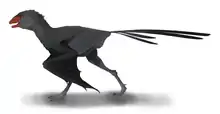 Ambopteryx  Aorun 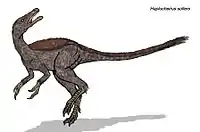 Haplocheirus  Guanlong  Xiaotingia  Yi 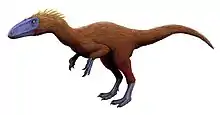 Zuolong | ||
| Callovian-Oxfordian | Liaoning, China | Ambopteryx is a genus of scansoriopterygid theropod. It is the second dinosaur, after Yi, to be found with both feathers and bat-like membranous wings. | ||
| Callovian-Oxfordian | Shishugou Formation, Xinjiang, China | An unspecified basal tyrannoraptoran, possibly an alvarezsaur, that was at most 1 meter (3.3 feet) long and 2 kilograms (4.4 pounds) heavy.[4] | ||
| Tiaojishan Formation, Liaoning, China | An anchiornithid theropod, measuring about half meter long. May be the most basal avialan dinosaur known to date. | |||
| Tiaojishan Formation, Hebei, China | A small paravian theropod, most likely an anchiornithid. Its holotype, an adult individual, consists of a complete articulated skeleton compressed on a slab and counterslab with soft tissues and extensive actual remains (instead of imprints) of the plumage having been preserved, including nanostructures interpreted as melanosomes. The excellent state of preservation of the fossil enables for accurate reconstructions of its living appearance down to details like its plumage's coverage and potentially even its coloration, including iridescence. | |||
| Tiaojishan Formation, Liaoning, China | A small anchiornithid, at first believed to be a troodont, known from a single specimen of a subadult or adult individual's nearly complete skeleton. | |||
| Daohugou Beds, Inner Mongolia, China | Epidexipteryx is a genus of small paravian dinosaurs in the family Scansoriopterygidae. | |||
| Shishugou Formation, Junggar Basin of Xinjiang, China | A basal alvarezsaur that was the largest known definite member of the superfamily, at around 2 meters long, and one the oldest. | |||
| Shishugou Formation, Xinjiang, China | A proceratosaurid that was one of the earliest tyrannosaurs, about 3 meters (9.8 feet).[5] It has a large distincitve crest on its head, a feature seen in many primitive tyrannosaurs. | |||
| Linglongta area, Jianchang, Tiaojishan Formation, Liaoning, China | A paravian theropod, possibly an anchiornithid, measuring about 60 cm long and less than a kilogram. It had feathers on its head, body, forelimbs and hind limbs. | |||
| Tiaojishan Formation, Hebei, China | Yi is a genus of scansoriopterygid dinosaurs. It is the first dinosaur to be found with both feathers and bat-like membranous wings. | |||
| Oxfordian- early Kimmeridgian | Shishugou Formation, Junggar Basin of Xinjiang, China | Zuolong is a primitive coelurosaurian, possibly the most primitive known. Estimated at 3 meters (9.8 ft) long and at 60 kilogrammes heavy the specimen known is probably from a juvenile animal, and is quite complete. | ||
Cephalopods
| Cephalopods of the Oxfordian | ||||
|---|---|---|---|---|
| Taxa | Presence | Location | Description | Images |
 Belemnite fossils | ||||
 An illustration of a variety of fossil nautiloids. | ||||
References
Notes
- For a detailed geologic timescale see Gradstein et al. (2004)
- Oxfordian is a word meaning "from Oxford" (see wiktionary:Oxfordian).
-
 One or more of the preceding sentences incorporates text from a publication now in the public domain: Howe, John Allen (1911). "Oxfordian". In Chisholm, Hugh (ed.). Encyclopædia Britannica. 20 (11th ed.). Cambridge University Press. p. 415.
One or more of the preceding sentences incorporates text from a publication now in the public domain: Howe, John Allen (1911). "Oxfordian". In Chisholm, Hugh (ed.). Encyclopædia Britannica. 20 (11th ed.). Cambridge University Press. p. 415. - Choiniere JN; Clark JM; Forster CM; Norell MA; Eberth DA; Erickson GM; Chu H; Xu X (2013). "A juvenile specimen of a new coelurosaur (Dinosauria: Theropoda) from the Middle–Late Jurassic Shishugou Formation of Xinjiang, People's Republic of China". Journal of Systematic Palaeontology. online (2): 177. doi:10.1080/14772019.2013.781067.
- Xu X., Clark, J.M., Forster, C. A., Norell, M.A., Erickson, G.M., Eberth, D.A., Jia, C., and Zhao, Q. (2006). "A basal tyrannosauroid dinosaur from the Late Jurassic of China". Nature. 439 (7077): 715–718. Bibcode:2006Natur.439..715X. doi:10.1038/nature04511. PMID 16467836.CS1 maint: multiple names: authors list (link)
Literature
- Brongniart, A.; 1829: Tableau théorique de la succession et de la disposition la plus générale on Europa, des terrains et roches, qui composent l'écorce de la terre, Paris.(in French)
- Gradstein, F.M.; Ogg, J.G. & Smith, A.G.; 2004: A Geologic Time Scale 2004, Cambridge University Press.
External links
- GeoWhen Database - Oxfordian
- Jurassic-Cretaceous timescale, at the website of the subcommission for stratigraphic information of the ICS
- Stratigraphic chart of the Upper Jurassic, at the website of Norges Network of offshore records of geology and stratigraphy




